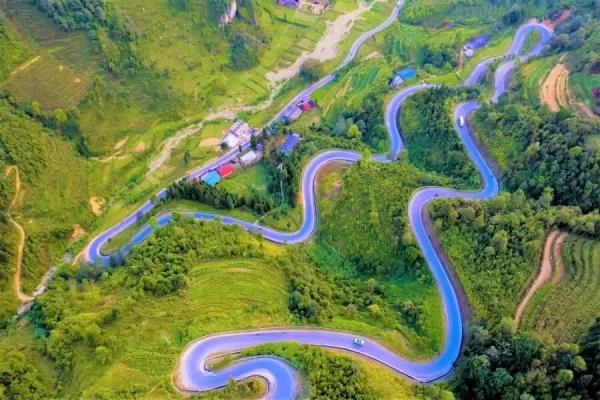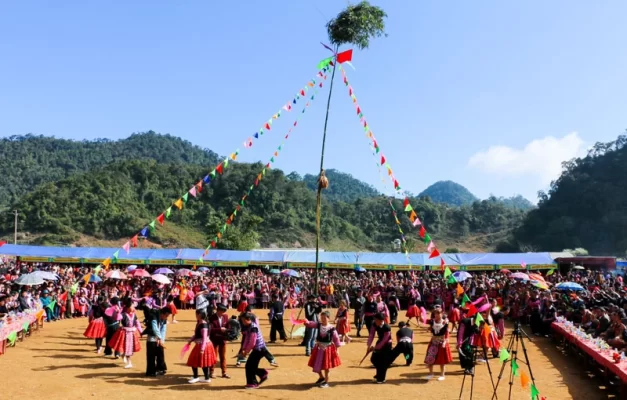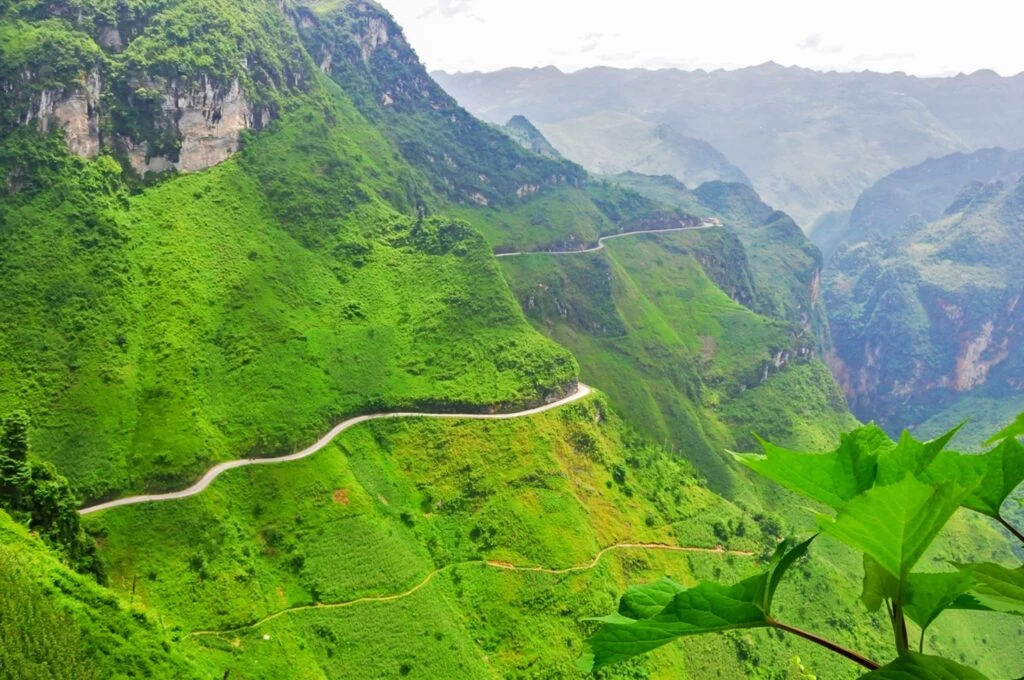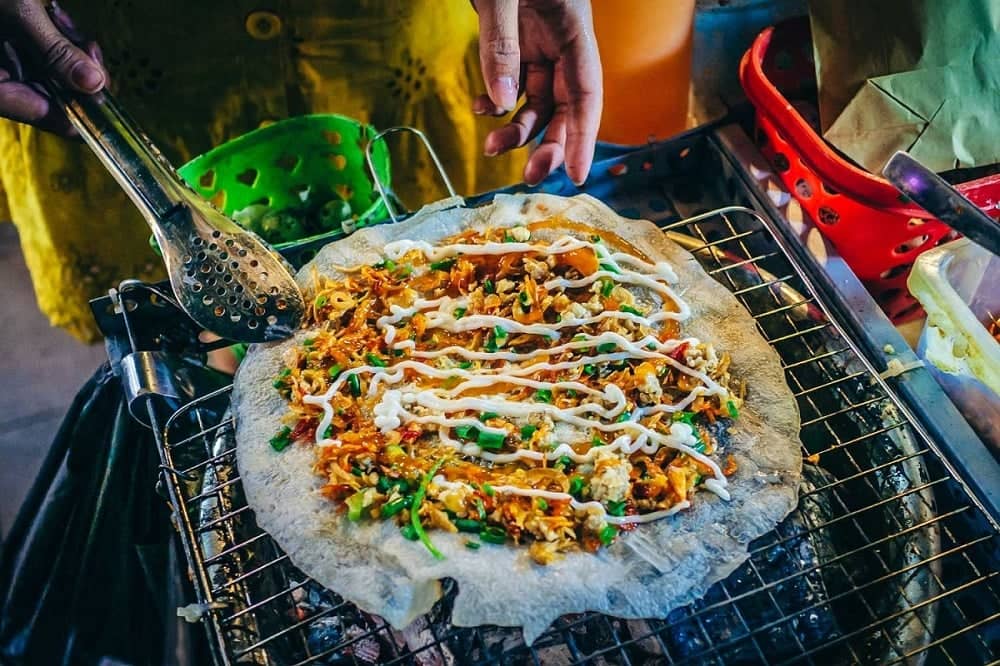
Let’s explore interesting things in Ha Giang!
Discover the top best 6 things to do in Ha Giang. From the stunning Ma Pi Leng Pass and Dong Van Karst Plateau Geopark to vibrant ethnic minority villages and local markets, immerse yourself in the natural beauty and rich cultural heritage of Ha Giang. Enjoy thrilling motorbike tours, traditional homestays, and unique culinary experiences like savoring local specialties and corn wine. Explore historical sites, festivals, and adventure activities that make Ha Giang a must-visit destination for international travelers seeking an authentic Vietnamese adventure.
I. Introduction to Ha Giang
1. Overview of Ha Giang
Ha Giang, located in the far north of Vietnam, is a province that captivates travelers with its breathtaking landscapes, rich cultural heritage, and the unspoiled beauty of its natural environment. Nestled in a rugged mountainous region, Ha Giang is offering dramatic views of steep limestone cliffs, winding rivers, and terraced rice fields. The province’s remoteness and relatively undeveloped tourism infrastructure add to its charm, making it an ideal destination for adventurous travelers seeking authentic experiences.
2. What Makes Ha Giang so Attractive?
The allure of Ha Giang lies not only in its stunning scenery but also in its vibrant cultural diversity. This region is home to several ethnic minority groups, including the H’Mong, Dao, Tay, and Lo Lo, each with its own unique customs, traditions, and way of life.
Visitors have the rare opportunity to immerse themselves in the daily lives of these communities, whether it’s by visiting traditional markets, staying in local homestays, or participating in age-old festivals. The cultural richness of Ha Giang is evident in its traditional clothing, architecture, and handicrafts, providing a deep and immersive cultural experience for anyone who visits.
II. Explore Ha Giang’s Scenic Landscapes
1. Ma Pi Leng Pass
Ma Pi Leng Pass is often regarded as one of the most spectacular mountain passes in Vietnam, if not all of Southeast Asia. Stretching for about 20 kilometers, this winding road hugs the mountainside, offering breathtaking views of steep cliffs, deep valleys, and the serene Nho Que River flowing far below. The pass reaches an elevation of about 1,200 meters, and its dramatic twists and turns reveal new perspectives of Ha Giang’s rugged beauty with every curve.

Ma Pi Leng Pass
Adventurous travelers can experience Ma Pi Leng in several ways. For those seeking an adrenaline rush, trekking along the trails surrounding the pass provides an up-close encounter with the region’s stunning natural features. Hiking paths will lead you through terraced fields, rocky outcrops, and viewpoints that offer unparalleled panoramic vistas.
Start your journey now: Ha Giang Tour Package 5D4N
2. Dong Van Karst Plateau Geopark
Dong Van Karst Plateau Geopark is a UNESCO Global Geopark, recognized for its unique geological formations and rich cultural heritage. Covering an area of over 2,300 square kilometers, this vast limestone plateau is a treasure trove of natural and cultural wonders. The landscape here is characterized by towering karst peaks, deep valleys, and mysterious caves, some of which are believed to be millions of years old.

Dong Van Karst Plateau Geopark
Visitors can venture into ancient villages such as Sung La and Pho Cao, where traditional houses built from clay and stone stand amidst terraced fields and orchards. The local ethnic communities, including the H’Mong, Tay, and Lo Lo, still practice age-old customs and agricultural methods.
A visit to the Dong Van Old Quarter is another highlight; this historic town features well-preserved houses dating back hundreds of years, reflecting a blend of local and colonial architecture. Exploring this area offers insight into the harmonious coexistence of nature and culture in Ha Giang.
More details: Ha Giang to Cao Bang Tour
3. Lung Cu Flag Tower
Lung Cu Flag Tower stands as a powerful symbol of Vietnam’s sovereignty, marking the northernmost point of the country. Situated at an altitude of about 1,470 meters, the tower proudly displays the national flag atop Dragon Mountain. To reach the top, visitors must climb 389 stone steps, a journey that is both physically demanding and emotionally rewarding. At the summit, a massive 54-square-meter flag flutters in the wind, representing the 54 ethnic groups of Vietnam.

Lung Cu Flag Tower
The panoramic view from the top of Lung Cu Flag Tower is nothing short of awe-inspiring. On clear days, visitors can see far into the mountainous terrain, with terraced fields cascading down the slopes and small villages nestled in the valleys below. Visiting Lung Cu offers not just a scenic journey but also a cultural one, as travelers can explore nearby villages like Lo Lo Chai to learn about local customs, crafts, and daily life.
III. Cultural Experiences
1. Visit Ethnic Minority Villages
Exploring Ha Giang’s ethnic minority villages offers a unique insight into the traditional lifestyles and cultures of communities such as the H’Mong, Dao, and Lo Lo people. These villages are not just tourist destinations but living cultural museums where centuries-old customs are still preserved.

Lung Cam Village
A visit to Lung Cam Village, for instance, allows you to see traditional H’Mong houses made of clay walls and tiled roofs. Another must-visit is Pa Vi Village, nestled in the stunning Ma Pi Leng Pass. It is renowned for its beautifully preserved stilt houses and the vibrant daily life of the Lo Lo people. Visitors here can participate in community activities, witness traditional farming methods, and even join in local festivals, experiencing the authentic spirit of ethnic culture.
2. Explore Traditional Markets

Dong Van Market
Dong Van Market, held every Sunday, is one of the most famous. It’s not just a place for buying and selling goods but a weekly social gathering where ethnic minorities from the surrounding mountainous regions come together. You can find a diverse array of handmade textiles, intricate silver jewelry, and traditional clothing here.

Meo Vac Market
Meo Vac Market, held every Sunday as well, is known for its lively atmosphere. The market showcases an incredible array of local products, including livestock, handicrafts, and vibrant produce. Engaging with the locals at these markets provides a rich, immersive cultural experience, allowing you to understand the diverse traditions of Ha Giang’s ethnic communities.
3. Homestay Experience
Staying in a homestay is one of the most immersive ways to experience Ha Giang’s culture. Many ethnic minority families open their homes to visitors, offering not just accommodation but an opportunity to live as the locals do.

Homestay in Du Gia village
In villages like Du Gia, you can stay with a Tay family in their traditional wooden stilt house, complete with thatched roofs and bamboo walls. These homestays often include home-cooked meals featuring local ingredients, giving guests a taste of authentic Ha Giang cuisine.
Additionally, hosts frequently offer cultural activities such as cooking classes, where you can learn to make traditional dishes, or handicraft workshops, allowing you to try your hand at making items like embroidered cloths or bamboo baskets. Through these experiences, you gain a deeper appreciation of the daily life, traditions, and warm hospitality of Ha Giang’s ethnic people.
IV. Visit Historical and Cultural Sites
1. H’Mong King Palace

H’mong King Palace
The H’mong King Palace, also known as Dinh Vua Mèo, is an architectural marvel nestled in the Sa Phin Valley. Built in the early 20th century by the Hmong leader Vuong Chinh Duc, this palace is a symbol of the Hmong people’s power and influence in the region.
- Architectural Significance: The palace is a blend of Chinese, French, and Hmong architectural styles, featuring intricate wood carvings, stone walls, and courtyards. It covers an area of about 1,120 square meters, comprising 64 rooms, with each room meticulously designed to reflect the cultural and social status of its inhabitants.
- Cultural Insights: Walking through the palace, visitors can learn about the lifestyle of the Hmong royal family, their traditional customs, and their historical role in the region. The palace also contains relics and artifacts that provide a glimpse into the lives of the Hmong people during the early 20th century.
2. Dong Van Ancient Town

Dong Van Ancient Town
Dong Van Ancient Town is a small, historical town that dates back hundreds of years. It is known for its traditional houses, ancient streets, and the cultural diversity of its inhabitants. The town is a melting pot of various ethnic groups, each contributing to the rich cultural tapestry of the area.
- Cultural Experiences: A stroll through the narrow streets of Dong Van Ancient Town feels like a journey through time. Visitors can explore ancient houses, local shops, and the bustling weekend market, where ethnic minority people gather to trade goods. The market is a vibrant display of local culture, with traditional attire, handcrafted goods, and local delicacies.
- Night Experience:In the evenings, the town transforms into a charming setting with traditional lanterns illuminating the streets, offering a tranquil and nostalgic atmosphere. Sometimes, cultural performances and local festivals are held here, providing a deeper cultural immersion.
V. Adventure Activities in Ha Giang
1. Motorbike Tours
Exploring Ha Giang by motorbike is one of the most exhilarating ways to experience its stunning scenery. The winding roads, flanked by towering karst mountains and deep valleys, offer a sense of freedom and adventure. The Ha Giang Loop, a popular route, takes around 3-4 days to complete and covers approximately 350 kilometers of awe-inspiring landscapes.

Motorbike tour in Ha Giang Loop
Key segments of the loop include the Dong Van Plateau, Ma Pi Leng Pass, and the Meo Vac Valley. Riding through these routes, travelers can stop at ethnic minority villages, interact with locals, and capture incredible photographs of the terraced rice fields and dramatic mountain views. For those not comfortable riding a motorcycle themselves, there are guided tours available with experienced local drivers who can safely navigate the challenging terrain.
2. Trekking and Hiking

Trekking in Ha Giang
Ha Giang’s rugged terrain makes it an ideal destination for trekking and hiking enthusiasts. There are numerous trails catering to different levels of fitness and experience.
- One of the most popular trekking routes is through the Yen Minh Pine Forest, a serene area offering a peaceful escape amid nature.
- Another notable trekking destination is the Sung La Valley, where visitors can wander through picturesque landscapes dotted with traditional houses of the Hmong people.
- For a more challenging trek, adventurers can explore the Ta Luy Mountain or the Quan Ba Twin Mountains, where they will be rewarded with panoramic views of the surrounding karst formations.
3. Rafting and Kayaking

Kayaking on Nho Que river
While less known, river rafting and kayaking are slowly gaining popularity in Ha Giang, particularly along the Nho Que River. This river winds its way through the deep gorges of the Ma Pi Leng Pass, offering a unique perspective of the towering cliffs and lush vegetation. Kayaking here provides a tranquil experience, allowing visitors to glide through the calm waters while taking in the dramatic landscape.
VI. Festivals and Events
1. Ha Giang Buckwheat Flower Festival

Buckwheat Flower Festival
The Buckwheat Flower Festival is one of the most anticipated events in Ha Giang, celebrated annually when the fields burst into bloom with stunning pink and purple buckwheat flowers. This festival typically takes place between late October and early November, coinciding with the peak flowering season. During this time, Ha Giang’s landscapes are transformed into a colorful tapestry of rolling hills covered in buckwheat flowers, attracting photographers, nature lovers, and cultural enthusiasts.
2. Ethnic Cultural Festivals
Ha Giang is home to a diverse array of ethnic groups, each with its own unique customs and traditions. Throughout the year, various ethnic cultural festivals take place, offering visitors a chance to experience the vibrant cultural tapestry of the region.

Gau Tao Festival
One of the most significant festivals is the Gau Tao Festival, primarily celebrated by the Hmong people. This festival usually occurs during the Lunar New Year period (Tet) or in spring and serves as a way to pray for prosperity, health, and good harvests.
The Gau Tao Festival is marked by lively activities such as traditional dances, folk songs, and sports competitions like tug-of-war, crossbow shooting, and horse racing. The event provides a unique glimpse into the spiritual and social life of the Hmong community.
VII. Unique Culinary Experiences in Ha Giang
1. Try Local Cuisine
Among the must-try delicacies is Thang Co, a traditional dish of the H’Mong people, made primarily from horse meat, organs, and bones, simmered with a mix of local herbs and spices. This dish has a distinct aroma and is often enjoyed during local markets or festivals.
Another specialty is Pho Chua, or sour noodle soup. Unlike the famous Hanoi-style pho, this version includes noodles served with a tangy broth, often mixed with pickled vegetables, peanuts, and slices of fried pork or beef. The dish is a perfect balance of flavors, combining the sourness of the broth with the richness of the toppings.

Smoked Buffalo Meat
For those who enjoy meat dishes, Smoked Buffalo Meat (Thit Trau Gac Bep) is a must-try. Prepared by the Tay and Nung ethnic groups, this dish features strips of buffalo meat marinated with local spices and then smoked over a fire for several hours. The result is a tender, smoky-flavored meat that pairs perfectly with a cold beer or a shot of local corn wine.
2. Corn Wine

Corn Wine
No culinary journey in Ha Giang would be complete without sampling Corn Wine (Ruou Ngo). This traditional alcoholic beverage is a staple in the daily life of the H’Mong people, often brewed at home using locally grown corn.
The brewing process involves fermenting ground corn with yeast and then distilling it to produce a strong, clear spirit. The result is a potent drink with a distinct corn flavor that can range from mildly sweet to quite robust, depending on the distillation process.
VIII. Best Time for the Best Things to Do in Ha Giang
Ha Giang is a year-round destination, but certain times of the year offer particularly stunning experiences. Here are some of the best times to explore this beautiful region:
- Buckwheat Flower Season (October-November): One of the most iconic sights in Ha Giang is the blooming of the buckwheat flowers. From late October to early November, the landscape transforms into a sea of pink and purple flowers. This season not only provides breathtaking views but also cultural festivals celebrating the bloom.
- Rice Harvest Season (September): If you visit in September, you will be greeted by the golden terraced rice fields that cascade down the hillsides. This is a prime time for photography enthusiasts and nature lovers who want to capture the beauty of the harvest season in the mountainous regions of Ha Giang, particularly in places like Hoang Su Phi and Quan Ba.
- Water Pouring Season (May-June): During this period, the terraced fields are filled with water in preparation for planting. The reflection of the sky and surrounding landscape on the water-filled terraces creates a mesmerizing mirror effect, providing a unique and picturesque view of the region.
- Dry Season (October-April): For those who enjoy trekking and outdoor activities, the dry season offers cooler weather and less rain, making it ideal for exploring the rugged terrain and scenic roads. December to February can be quite cold, especially in higher altitudes, so it’s advisable to bring warm clothing.
In summary, Ha Giang offers an exceptional travel experience for international visitors, combining stunning natural landscapes, vibrant local cultures, and thrilling adventures. From the dramatic views of Ma Pi Leng Pass and the serene beauty of Dong Van Karst Plateau to the rich traditions of its ethnic communities and the distinctive flavors of its cuisine, Ha Giang stands out as a must-visit destination. Its unique blend of scenic beauty, cultural richness, and adventure ensures that every traveler leaves with unforgettable memories.
See more: Ha Giang travel tips



























